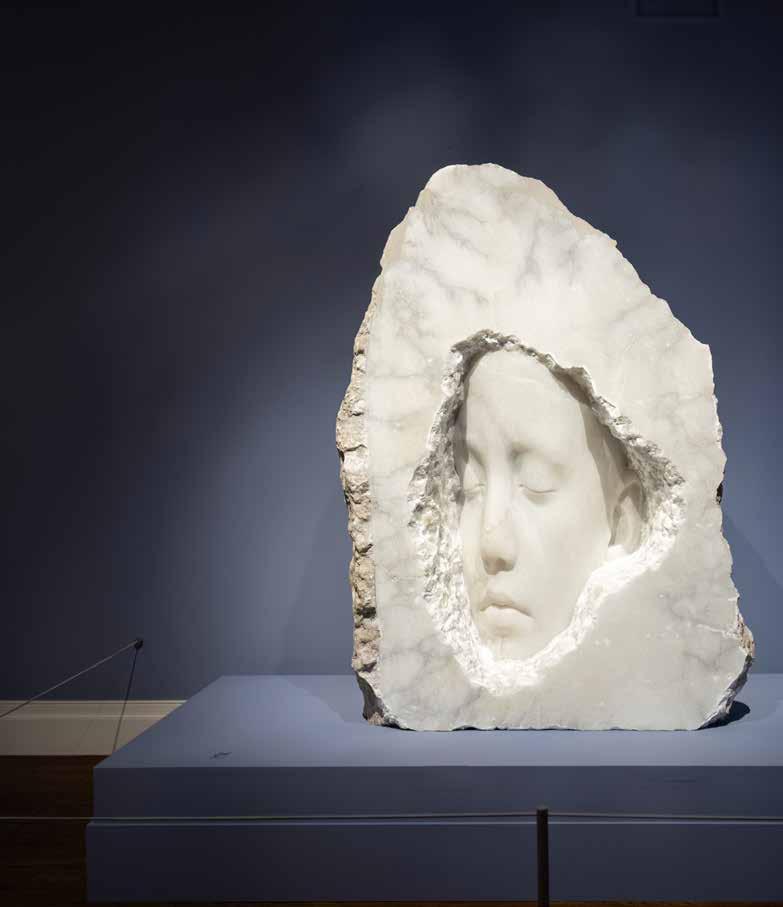
12 minute read
New acquisitions
IN NOVEMBER 2022 , HoMA’s collections committee approved the acquisition of two outstanding gifts. The first is Garden , painted in 1934 by the Enomoto Chikatoshi (1898–1973). One of the foremost Japanese artists of the early twentieth century, Chikatoshi is known for his portraits of Japanese women at leisure dressed in Western fashion. In Garden , women hold archery equipment, reflecting the evolution of gender roles in Japanese society at the time. The painting was featured in the fifteenth Imperial Academy of Fine Arts Exhibition (Teiten) at what is now known as the Tokyo Metropolitan Art Museum. Only the most distinguished artists were allowed to participate in these highly competitive, government-sponsored exhibitions.
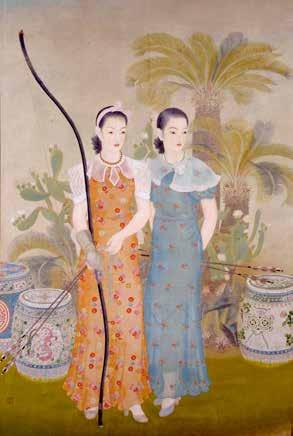
Advertisement
Around 1945, Garden entered the collection of the Meguro Gajoen Museum of Art in Tokyo. After the museum shut its doors in 2003, the painting was acquired by Patricia Salmon, a longtime supporter of HoMA and an important contributor to the internationally touring exhibition Taishō Chic: Japanese Modernity, Nostalgia, and Deco (2001–2005). HoMA has acquired a substantial collection of modern Japanese paintings through Ms. Salmon’s generous support, and Garden is a spectacular culmination of this relationship.
The second addition to HoMA’s collection is Enrique Chagoya’s Homage to Goya II: Disasters of War , a portfolio of ten aquatint prints produced between 1983–2003 and printed in 2003. Eight of these works put a contemporary spin on Francisco Goya’s (1746–1828) famous Disasters of War (1810–1820). Goya’s prints, kept secret during his lifetime, denounced Napoleon’s brutal occupation of Spain. Chagoya meticulously copied eight of Goya’s works, adding uncanny details and satirical substitutions that address issues of
American imperialism, border politics, and the art market. The remaining two prints, created in Goya’s style, present the artist as an heir to both Goya and the famous Mexican satirist José Guadalupe Posada.
HoMA’s permanent collection includes all of Goya’s prints in the Disasters of War series. The addition of Chagoya’s Homage offers the opportunity to bring the outstanding nineteenth- century Spanish artist into conversation with one of the most prominent Chicano artists working today. The portfolio was generously donated by Diane Evans, formerly curator of the Nevada Museum of Art in Reno and who served for nine years as executive director of the Museums of Sonoma County before moving to Honolulu in 2019.
GALLERY HIGHLIGHT
Jaume Plensa’s HORTENSIA (nest)
HORTENSIA (NEST) by renowned Spanish artist Jaume Plensa has joined the installation In Human Terms in HoMA’s Gallery 1, thanks to a generous loan from HoMA Trustee Sharon Twigg-Smith. The installation brings together a range of perspectives on the human figure, from some of its earliest manifestations in the ancient world to its enduring presence and power in contemporary art.
HORTENSIA , which weighs nearly 2,400 pounds, is a striking contrast between rough stone and a serene portrait of a young woman—Plensa describes his work as merging the exactness and immediacy of photography with the solidity and endurance of sculpture. Beginning with a three-dimensional scan of his subject’s head, the artist subtly distorts the digital image then transfers it to the stone with a precision milling process. Although his works depict specific people, Plensa’s portrait sculptures attempt to capture something universal about the body and the human experience.
HORTENSIA is part of the artist’s Nest series. The figure emerging from a block of luminous alabaster recalls the words of Michelangelo, who said the sculptor’s task is to release the figure that already exists within the stone. “For me,” Plensa says, “the head is the nest where our dreams are born.”
Process over product
FOR AARON PADILLA, HoMA’s Director of Learning and Engagement, reimagining the museum’s Artist in Residency program began with the tiny pieces of plastic that wash up on the shores of O‘ahu. He had taken UK-based artist Rebecca Louise Law, at her request, to the beach. It sounds like an obvious first destination for a visitor. But for Law, it wasn’t an exercise in reconstructing a tourist’s view of the island. It was because she had heard about the damage of marine plastics and wanted to see the impact firsthand.
That visit made such an impression on Law that it carried through to her work as an artist. For the first time in her career, she incorporated this type of human-produced waste into her nature-based installations, additions she hoped would reflect the dire consequences of our actions on our environment’s health.
It was a prime example of the cultural exchange that happens when artists come to the Islands—the impact of Hawai‘i on the artist, and of the artist on Hawai‘i. The experience inspired Padilla to relaunch an artist residency program at the Museum, with Law as the first participant, to facilitate cultural exchange and learning between an artist and the museum. Law returned to the island in December 2022 and spent two weeks learning from HoMA’s teaching artists, enriching their practices with her own fresh perspectives.
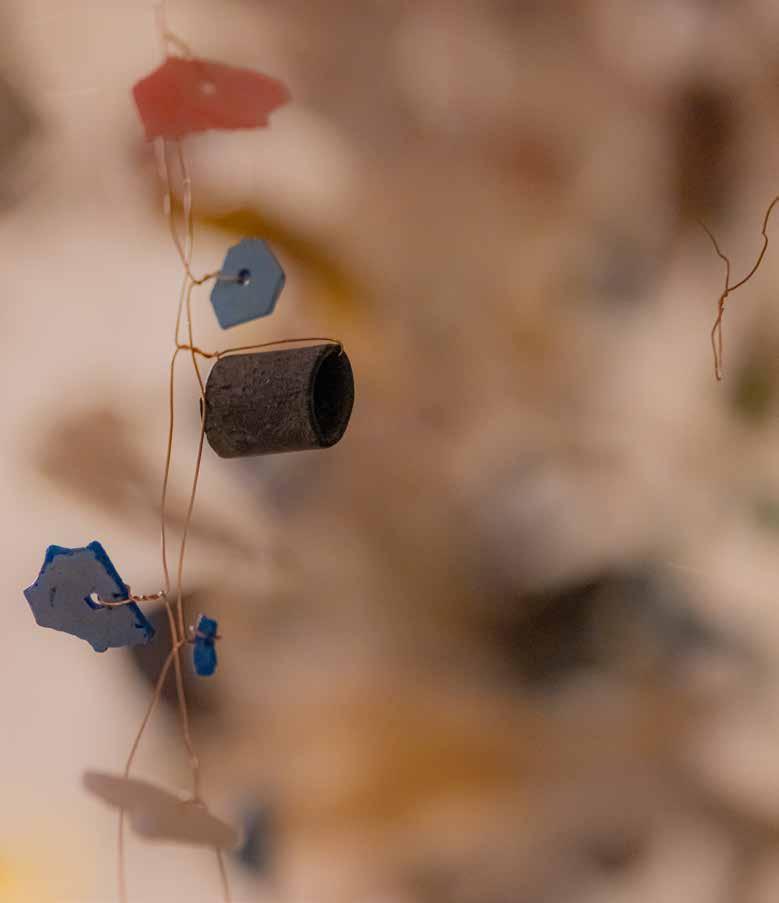
One of the primary goals of the HoMA Artist in Residency program will be to shed more light on the artistic journey and cross-pollinate ideas and techniques as contemporary artists from around the world are invited to participate. The influences of the residency are intended to be deeper and more open-ended than a one-off project.
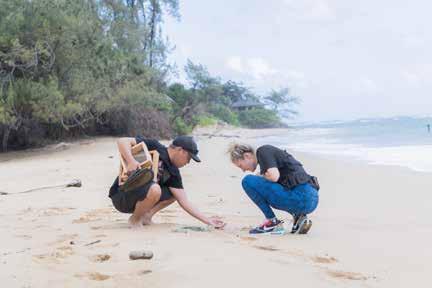
“Art is a process, and what we see hanging in our galleries are just snippets of a long film,” Padilla said. “You can view and interpret and read a work of art as it stands, but if you understand what has gone into creating it and if you’re privy to the broader context of an artist’s path, it makes the work a lot more enriching.” Padilla hopes each residency will reflect the artists involved, and include things like community conversations and opportunities to see artists creating or engaging with local artists and museum team members.
For Law, it was an opportunity to gain new techniques and grow without the pressure of deadlines or a final project. “Each session that I had with a teacher planted a seed in me,” she said. “It didn’t necessarily matter what was produced, it was teaching me how to work with different materials in different ways and putting that confidence in me. The teachers here were incredibly generous with their time and ideas, and I’ll take that with me.”
The exchange allows the museum to support contemporary artists and the art world beyond the museum’s walls, according to HoMA Director Halona Norton-Westbrook.
“Creative endeavors need nourishment, and artists need space and opportunities to create and learn,” Norton-Westbrook said. “It’s imperative for our institution to serve as a guide and an encouraging force in contemporary art making, not only housing completed works but inviting education and exploration. We’re grateful for the opportunity to connect influential contemporary artists with our HoMA community.”
The next participant, Ohio-based sculptor Matt Wedel, is slated to begin work at HoMA in summer 2023.
Understanding how art is formed—from the first sparks of an idea to the final displayed work, inception to completion—is one of the key principles of the new Artist in Residency program. Padilla says with the reopening of the Art School and the importance of art education to HoMA’s mission, it makes sense to reintroduce a residency program that centers on learning over finished works, prioritizing the creative journey in a cultural environment often hyper-focused on results and final products.
“Our residents will need to be artists, teachers and students—I think great residents are all three,” Padilla said. “Great artists are open and curious to what’s out there. They’re receptive to different ideas and perspectives and have the ability to synthesize and create. Hopefully this program can create a space for all of that to happen.”
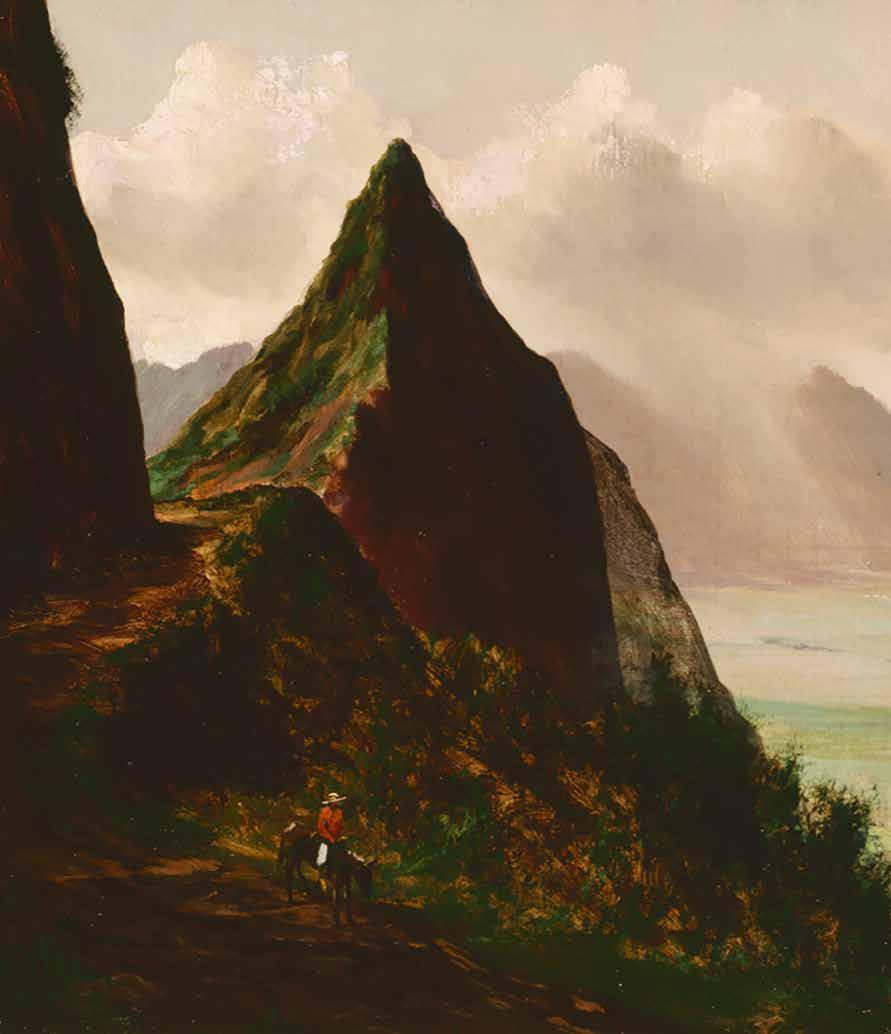
Reframing the landscape
John Dominis and Patches Damon Holt Arts of Hawai ‘ i Gallery will debut a reinstallation with new curatorial perspectives in spring 2023
REINSTALLING the museum’s Arts of Hawai‘i gallery was an immense task.
Nearly 200 works needed to be narrowed down to 40 for display. A new approach to storytelling had to be adopted, one that made space for new narratives to be told with the permanent collection’s works. And it would need to be collaborative, reflecting varied perspectives from different historians and art experts.
The key that unlocked a project that required so much fresh thinking came, though, from the most unexpectedly expected place: portrayals of landscapes.
It’s a familiar artistic construct, particularly in Hawai‘i, with its abundance of natural beauty. But the curators used landscapes as the frame for exploring deeper aspects of the archipelago’s identity—its social, political, cultural, and geographical layers.
The results will debut in spring 2023 in the John Dominis and Patches Damon Holt Art of Hawai‘i Gallery. The reinstallation—made possible thanks to the support of Judy Pyle and Wayne Pitluck— celebrates the dynamic visual culture of Hawai‘i, featuring works from HoMA's permanent collection and a few strategic loans across a variety of media and expressions.
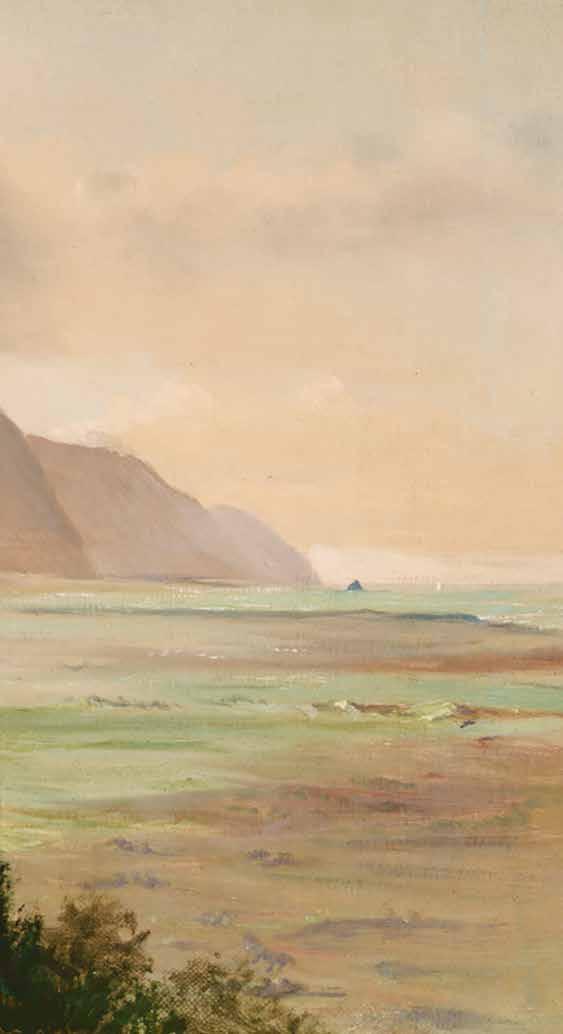
The landscapes theme came from the co-collaborators behind the reinstallation: Tory Laitila, HoMA’s Curator of Textiles and Historic Arts of Hawai‘i, and Rory Padeken, the O‘ahuraised guest curator currently serving as the Vicki and Kent Logan Curator of Modern and Contemporary Art at the Denver Art Museum. They intend to show a more rich and nuanced view of landscapes in all their layered meanings, rather than the traditional idea of postcard-like views of beautiful places.
“We’ve gathered artworks made from the nineteenth to twentieth centuries that show various places throughout the islands that are not Waikīkī or Lē‘ahi (Diamond Head), places and views of the land that you wouldn't necessarily find on a postcard or in a travel brochure,” Padeken said. “I am excited for visitors to see a group of engravings made between 1834 and 1844 by American Protestant missionary artist Edward Bailey alongside work by Native Hawaiian students and engravers who depicted various places on the islands of Maui and Hawai‘i. They are the complete opposite of his paintings that offer Eden-like views of Hawai‘i. In many ways, the engravings are more immediate and show Hawai‘i in transition as Western development begins to reshape the land. However, markers on the land that signify a Native Hawaiian sense of place also appear: the coconut groves that line the shore and traditional dwellings thatched with pili grass.”
The reinstallation explores the broad and varied identities that make up the culture of the islands and their artistic communities across centuries: Japanese and Filipino influences, immigrants from Korea and Micronesia, displaced Europeans, Scots who married into the Hawaiian monarchy—all are part of the historic fabric and society of Hawai‘i.
“This reinstallation will show the broadness of the ethnicities of the people and the artists represented, including Native Hawaiian and artists that worked, lived or were born in Hawai‘i,” Laitila said.
“People talk about Hawai‘i as a melting pot, but I like the word ‘stew,’ because we’re all combined and still retain our identities,” he continued. “Living here means you live in multiple communities and societies simultaneously. We live and work in all these layers, and those layers make up our landscape.”
It will also show the broad mediums employed by artists here: Theodore Wores’ 1901 oil painting The Lei Maker , one of the treasures of HoMA’s collection, will remain on view. Woodwork, like an ‘umeke poi from the eighteenth century, as well as quilting, feather work, engraving and printmaking will be on view as well. Artists like Lionel Walden, James Gay Sawkins, Isami Doi, Sean Browne, Marguerite Blasingame, and Reuben Tam will be represented.
Visitors will experience this expanded vision on both ends of the museum: more contemporary works toward the back of the gallery will be bookended by those in HoMA’s Gallery 14, where the focus will be on frequently changing exhibitions of contemporary art by local artists.
Reinstallation and reinterpretation of collections has become a common project and topic of conversation across museums in recent years as they seek to tell more authentic stories through their collections, part of the broader cultural push towards inclusivity.
“The traditional, chronological ways of telling histories at so many museums across the world often reinforce a linear or accepted canon of how things happened,” said Catherine Whitney, HoMA’s Director of Curatorial Affairs. “Reinstallation, if done well, can open up conversations and break down that canon of patriarchal, colonizing narratives so that we can tell new stories that are more diverse and more inclusive.”
Whitney says it was important to the curatorial team who worked on this iteration to approach it with a collaborative spirit, with the aim of sparking conversation rather than authoritatively defining past histories.
“The hope is that we are not just teaching a history or pointing to the past, but also showing how powerful these themes still are,” Whitney said. “The works are addressing some of the same human and societal issues we’re still grappling with today.”
Kaili Chun, 'Ama 'ama, 2018. Digital print on archival paper. Anonymous gift, 2018 (2018-24-01.03) 2018-24-01.03.

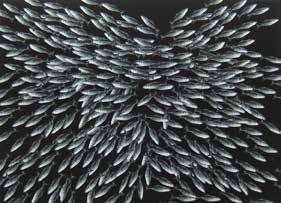
Welcome back, Jessica Welch, HoMA's new Chief Advancement Officer
The Honolulu Museum of Art’s new Chief Advancement Officer is no stranger to the museum—in fact, the newest member of HoMA’s leadership team worked here for thirteen years before departing in 2016 to become Executive Director of the Mānoa Heritage Center. “We’re thrilled to welcome Jessica back, and are fortunate that she is already so familiar with the museum’s history and fundraising needs,” said CEO and Director Halona Norton-Westbrook. “Her background in museum development and deep local connections will have a tremendous impact on our ability to serve this community for many generations to come.”

Welch returned to the museum in January. As head of the Advancement team, she’ll be responsible for raising HoMA to new levels of charitable funding, through major gifts, membership, fundraising events, and grants, and will collaborate with the Director and Board of Trustees to lead the museum’s strategic development efforts.
“I’m excited to return to the place where I spent most of my formative professional career,” Welch said. She described how walking the museum grounds brings back years of memories and feels like a homecoming. “When my daughters were small, they were always at the museum with me. Now returning as teenagers, they remember so much about the art and events we shared here years ago. Watching them engage with this place in new ways made me realize how special it is—I'm looking forward to building new memories at HoMA.”
Prior to being named executive director at Mānoa Heritage Center, Welch wore many hats at HoMA: over the years, her various titles included Associate Director of Development, Foundation Relations; Director of Institutional Planning & Support; and in 2013, Director of Development. In her three years as Director of Development, she launched a successful new membership program and built a highfunctioning Development team responsible for major gifts, planned giving, foundation grants, corporate sponsorships, membership, annual giving, and fundraising events.
“Over the course of my time at HoMA, I saw firsthand the huge impact that art makes in peoples’ lives,” Welch said. “And while the museum has always been a treasured resource, it’s been re-energized with a fresh vision and new strategic plan. It’s an honor to be part of this team embarking on truly transformative work.”
The HoMA community was deeply saddened by the December 2022 passing of Steve McClaran, a beloved member of the museum ‘ohana. Born and raised in Honolulu, with a distinguished U.S. Navy career and a small business of his own, McClaran was a dedicated docent for many years, volunteering at the museum well into his 90s. McClaran’s wife, Patsi, ran the front desk for over twenty years, and as a couple they were devoted to the museum.
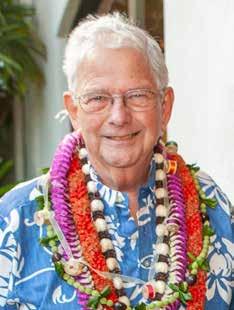
The docent community remembers McClaran as the consummate museum guide: incredibly kind, well-researched, and willing to share. “We’re all better people for knowing Stephen,” said Vicki Reisner, former Director of Volunteer and Visitor Services, who believes he may have been one of the museum’s first male docents. "One of the most remarkable things about him was that he was the expert on museum founder Anna Rice Cooke. He conducted tours centered around works of art that she donated to the permanent collection—he brought her back to life.”
In 2007, McClaran co-curated an exhibition with then museum Director Stephen Little titled A Vision of the World: The Anna Rice Cooke Collection at the Honolulu Academy of Arts exploring how Cooke built
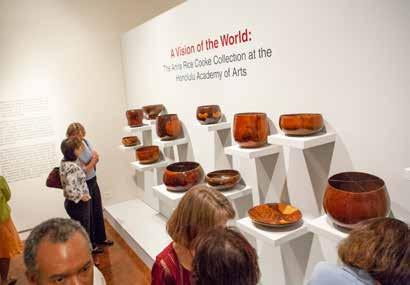
IN MEMORIAM: Steve McClaran
her remarkable collection, her intellectual curiosity, and her commitment to education as the foundation for the museum’s mission. “Stephen embodied the spirit of this place,” said Director of Learning and Engagement Aaron Padilla. “He approached everything with an open-minded eagerness to learn and brought that same enthusiasm when sharing HoMA’s gifts with our community.”
McClaran’s influence continues to be felt at HoMA through the friendships he forged and knowledge he shared. Former Curatorial Assistant Amber Ludwig Otero recalls reinstalling HoMA's porcelain collection with McClaran as her righthand man. “I told him that I was inspired by the porcelain room at the Seattle Art Museum,” Otero remembers, “and Stephen came back the next day with a diagram of how we could install our collection, and that’s what we used. The wall is still up today.”
To all who knew him, McClaran’s love of the museum—and the museum community—was evident. "He was in every piece of the museum,” said Otero. “And he gave the best life advice. The depth and breadth of the lives he touched is great.”






